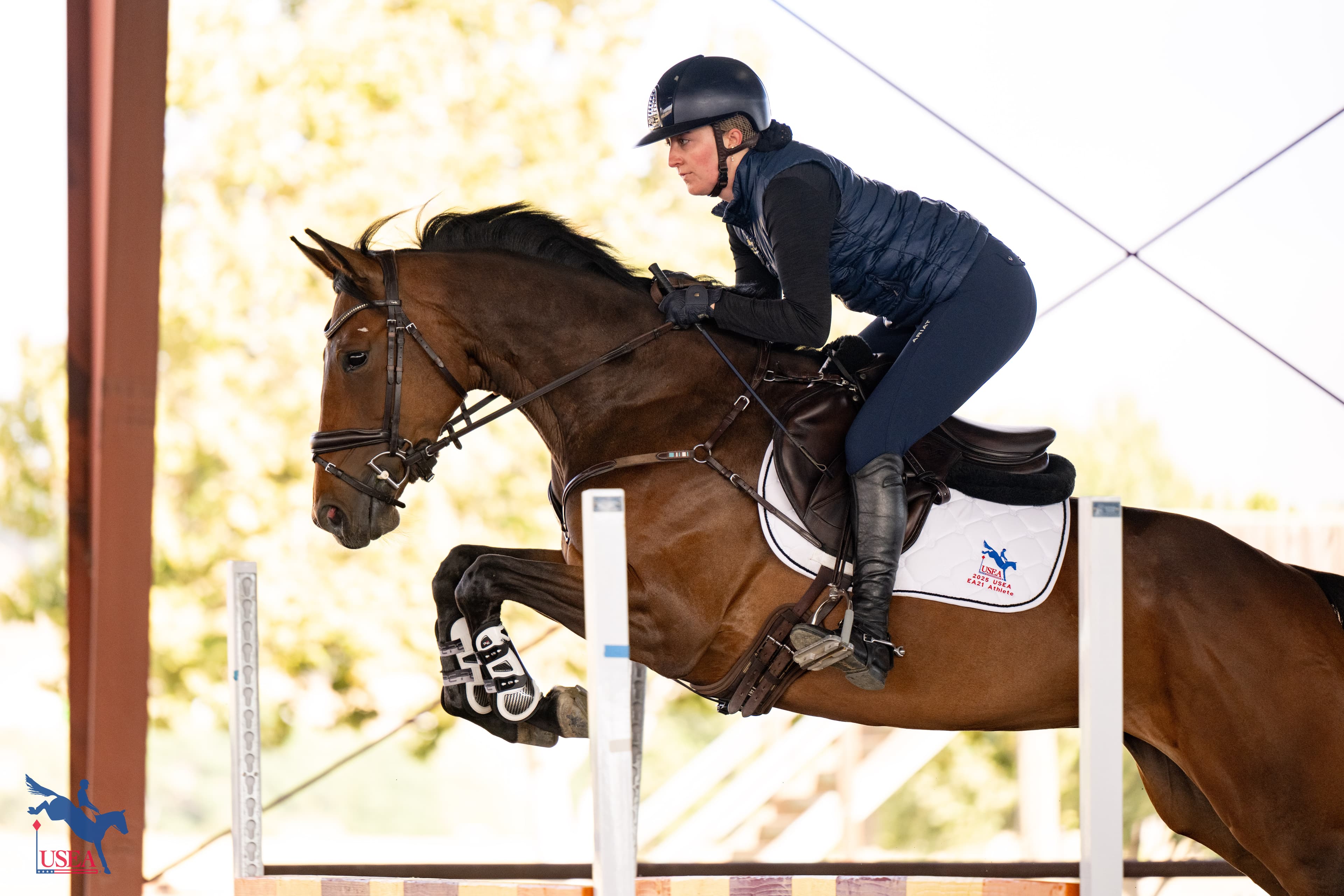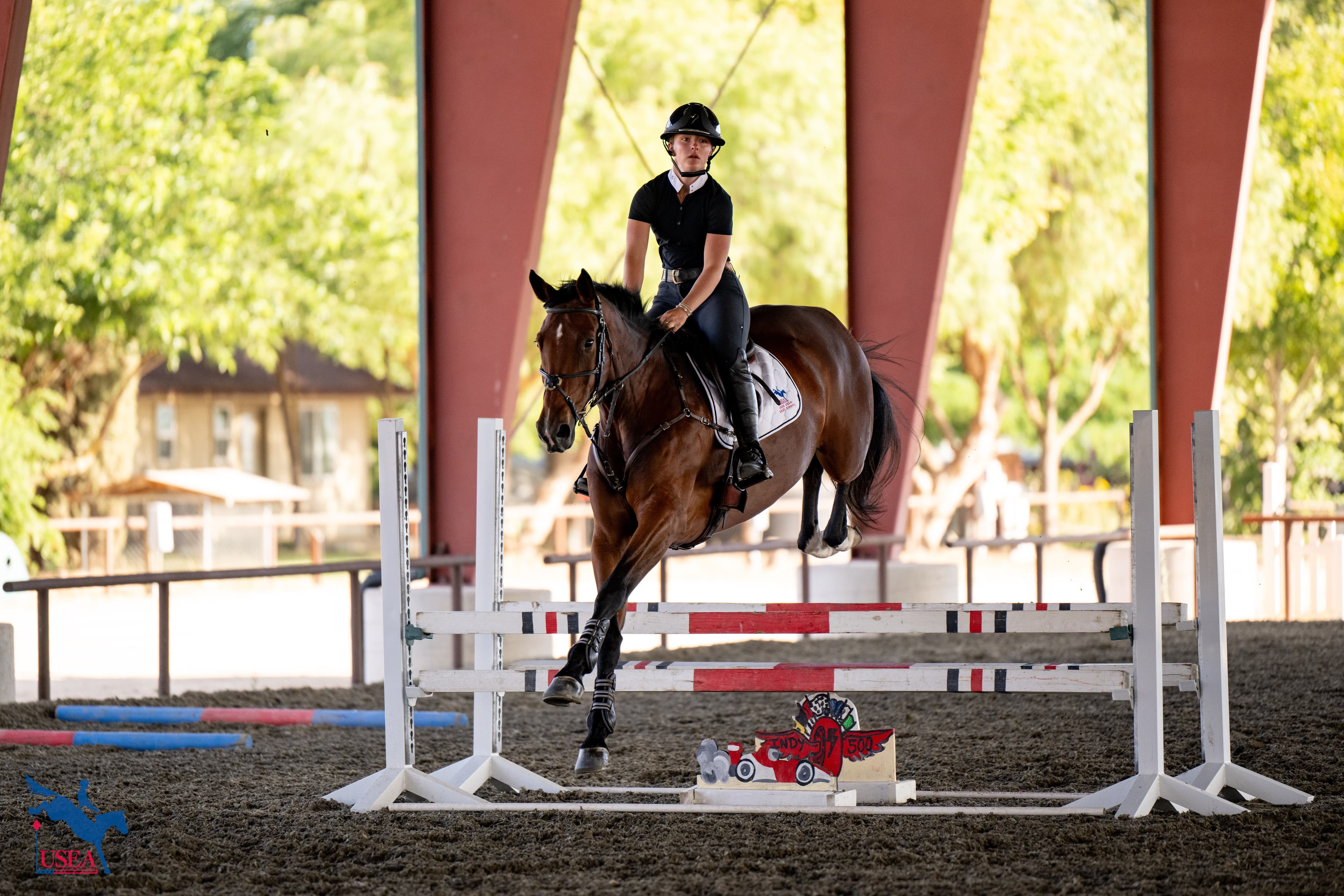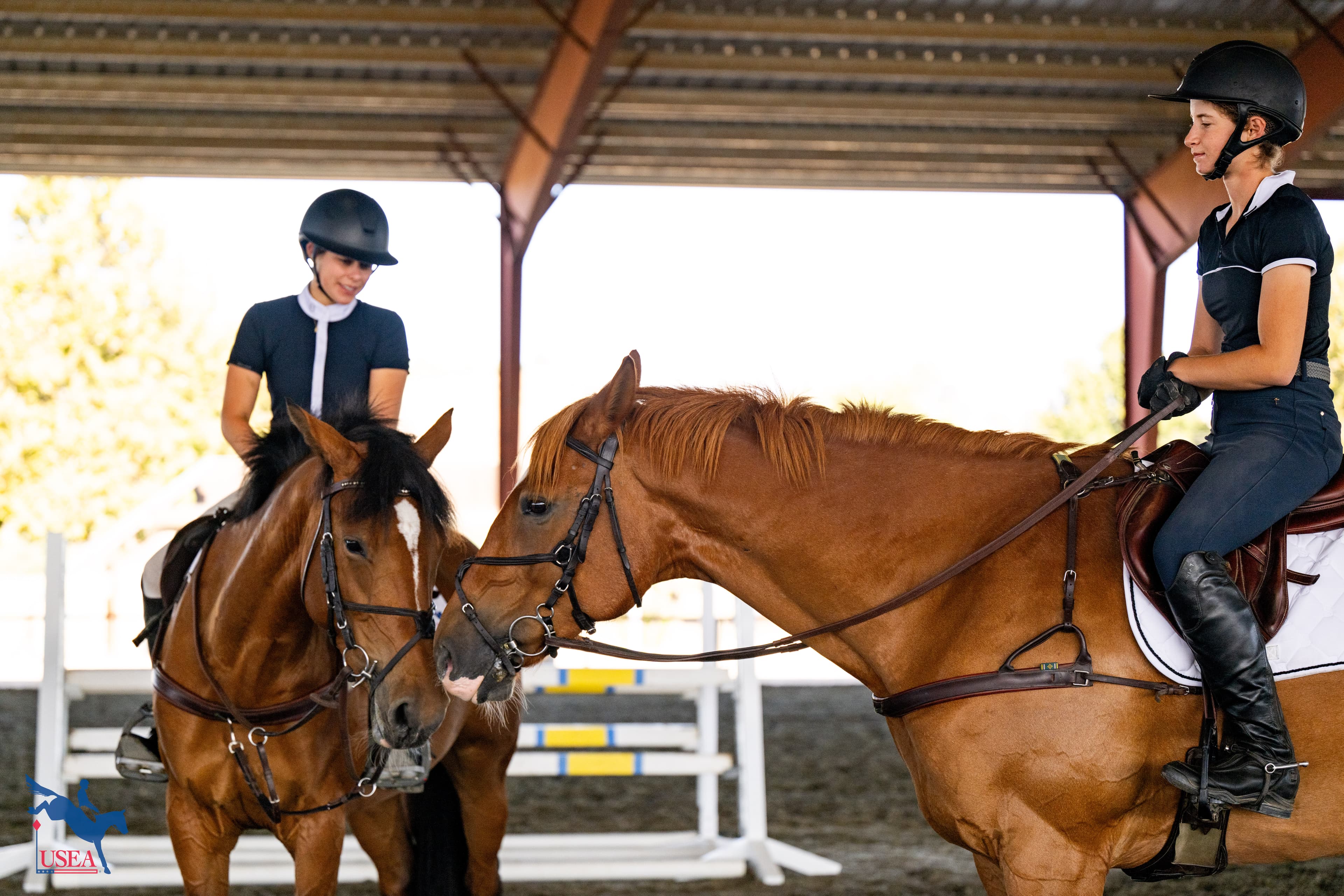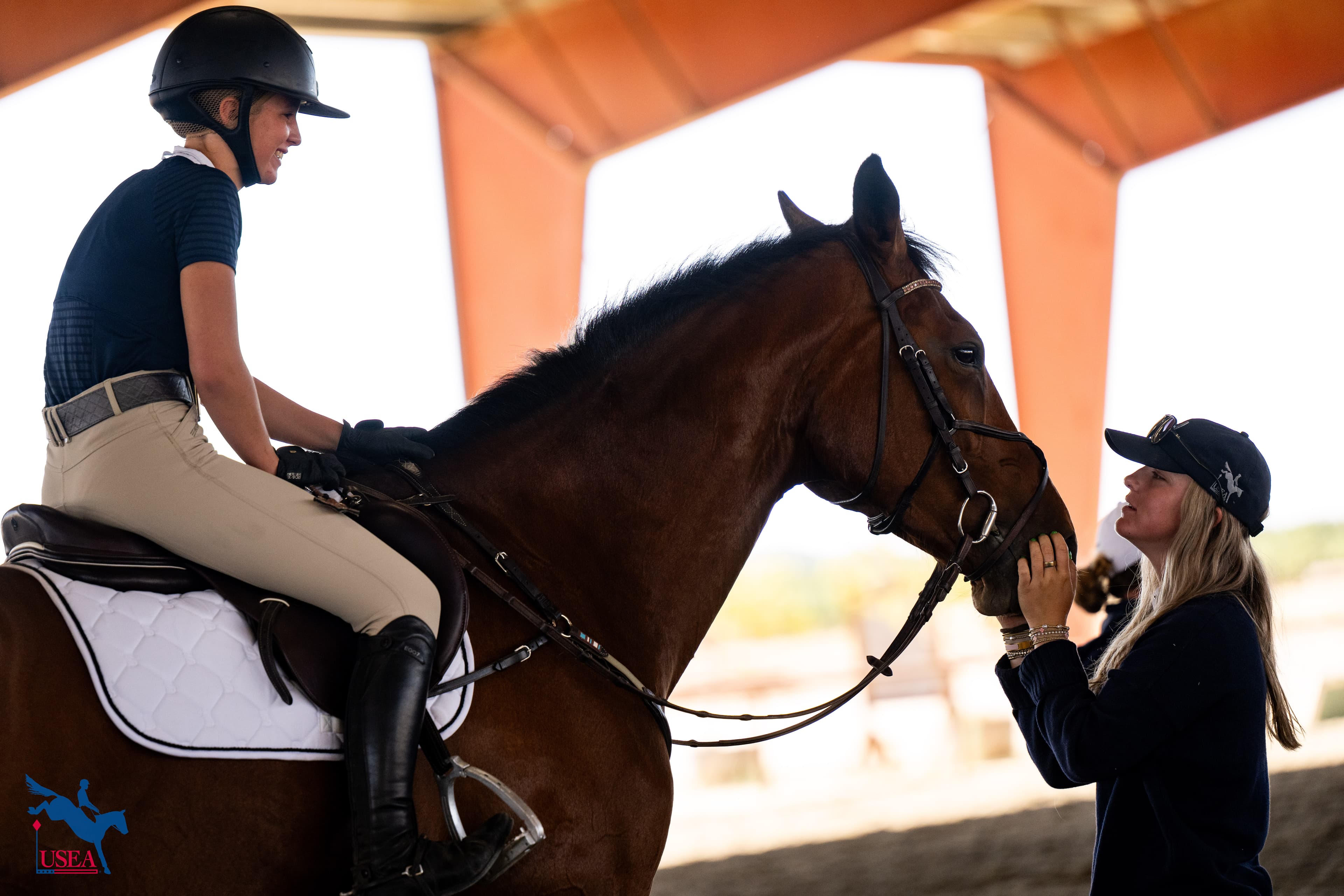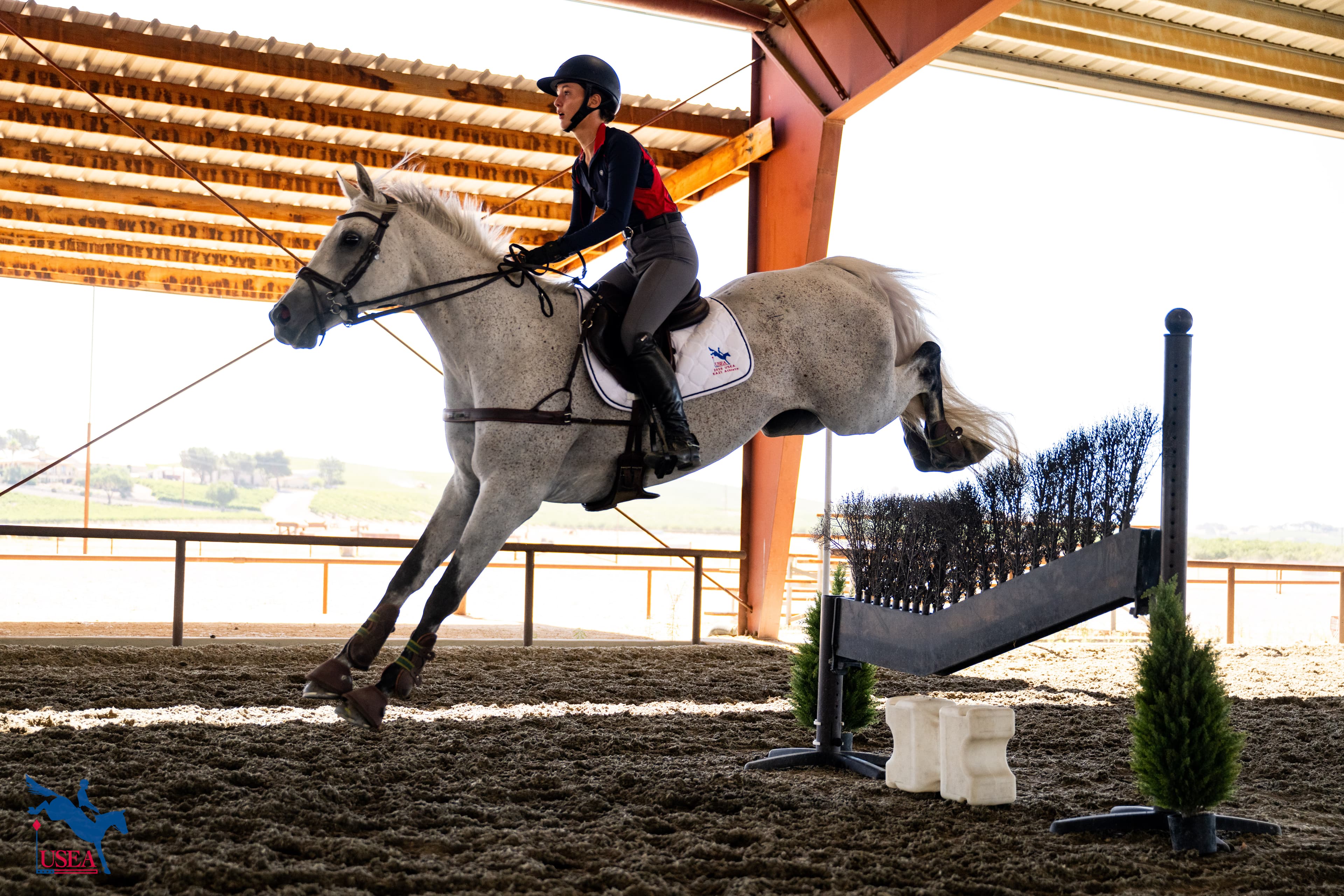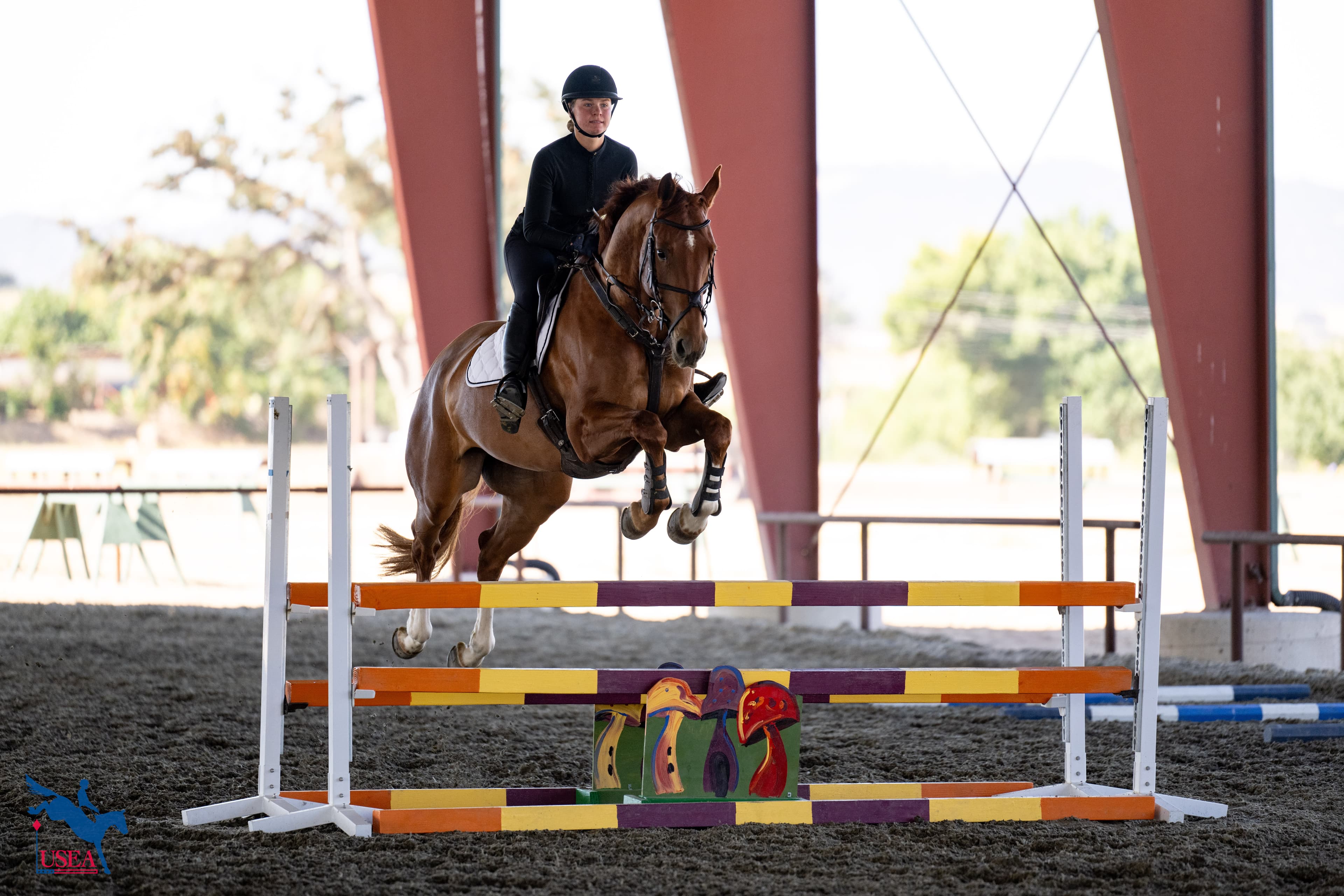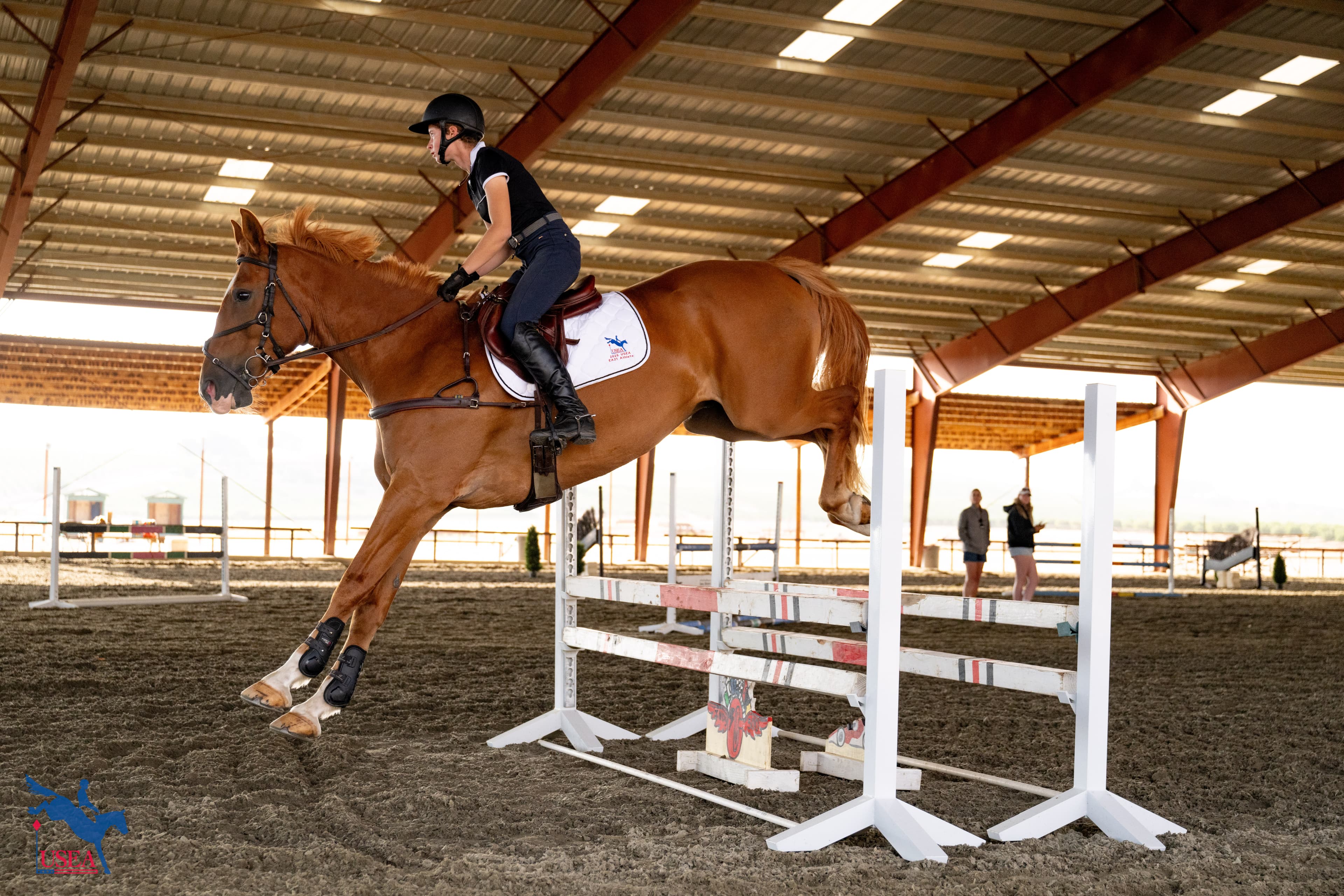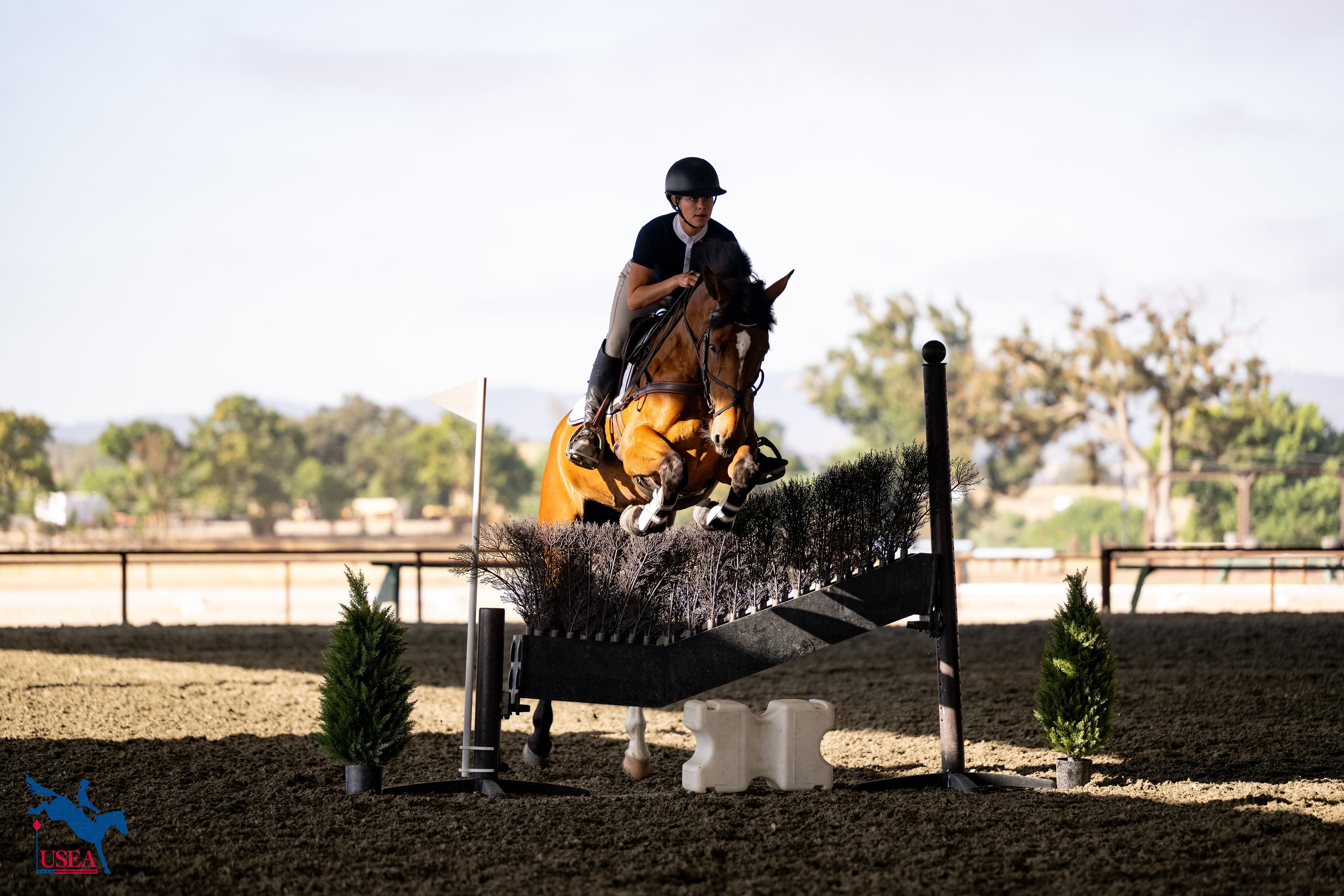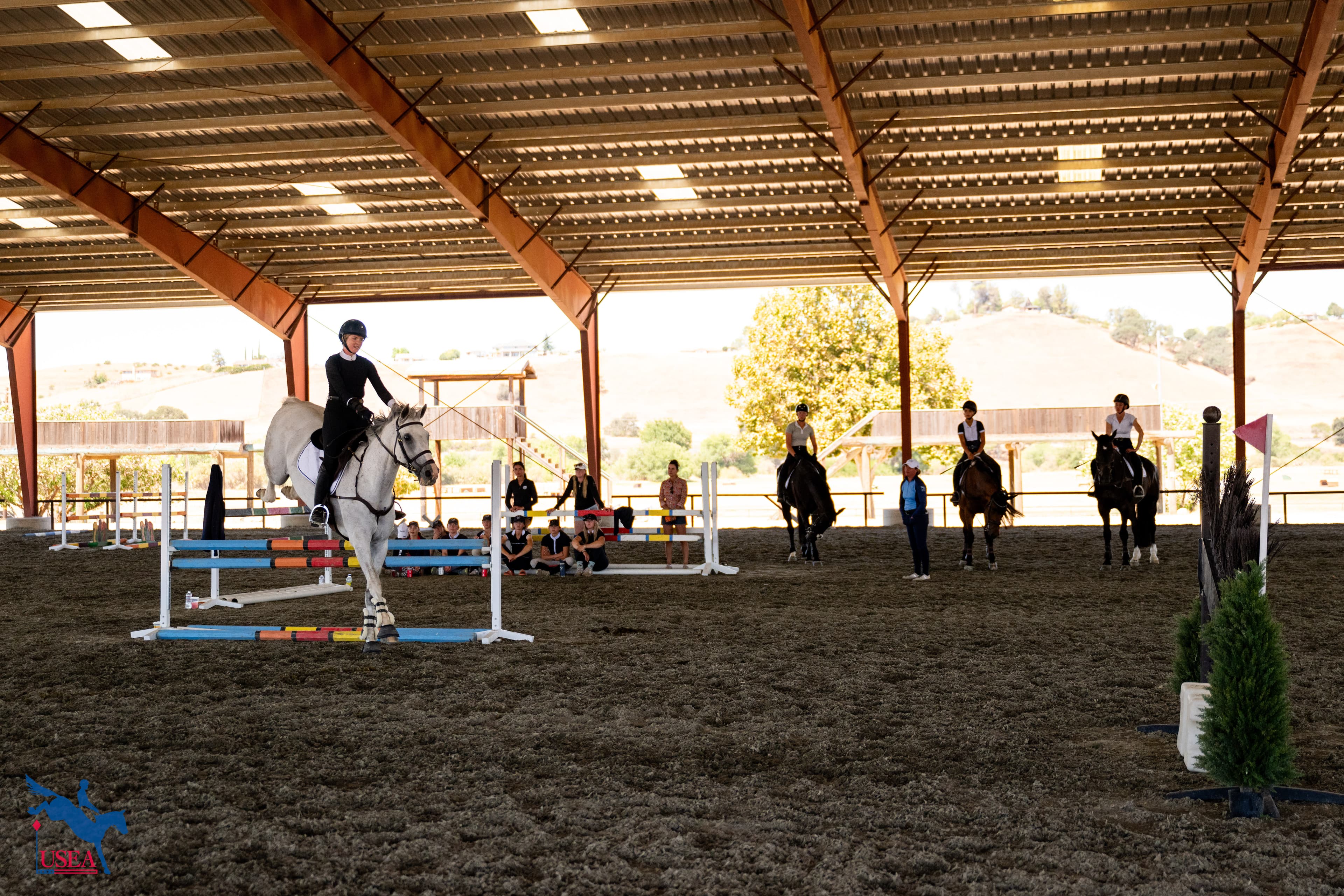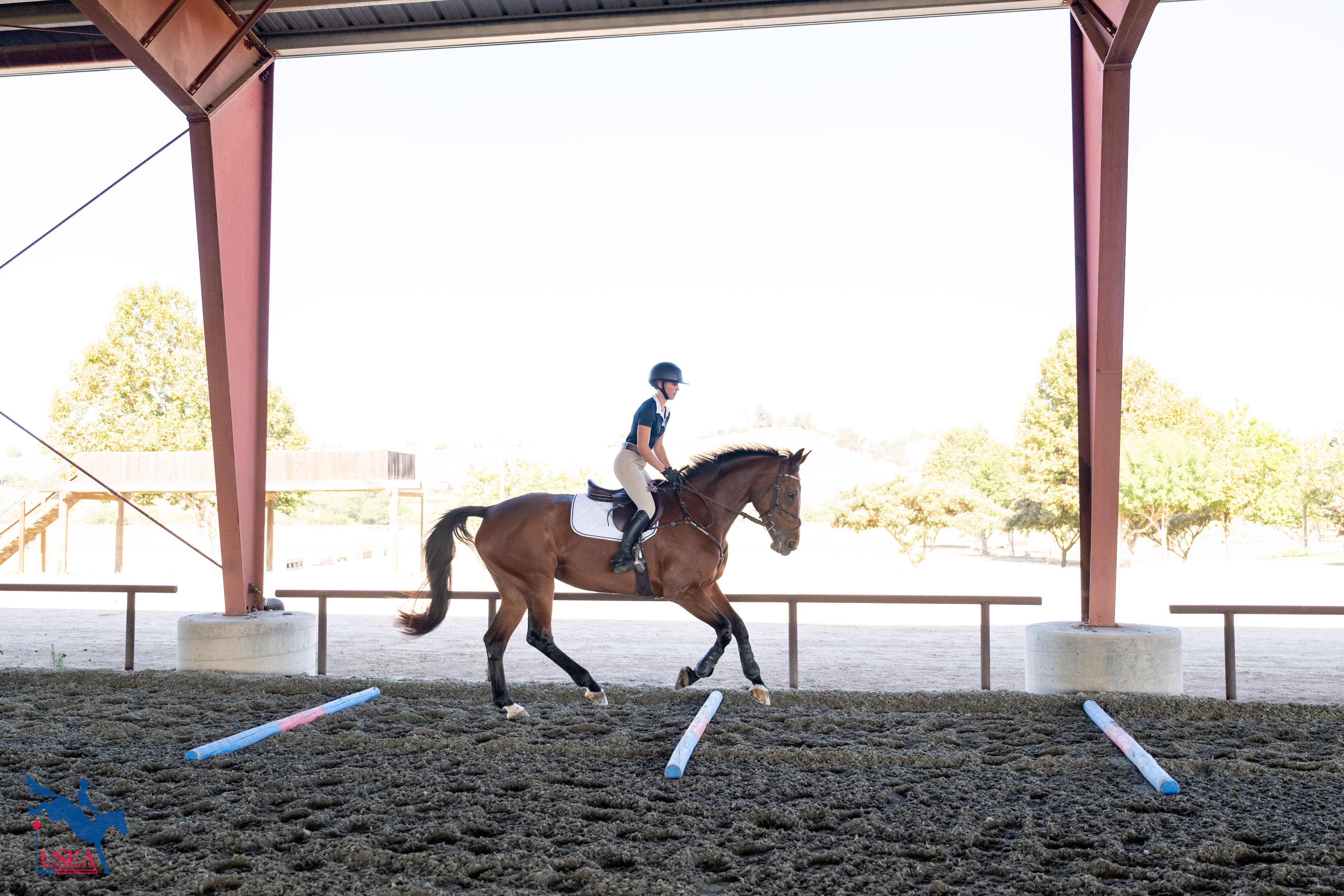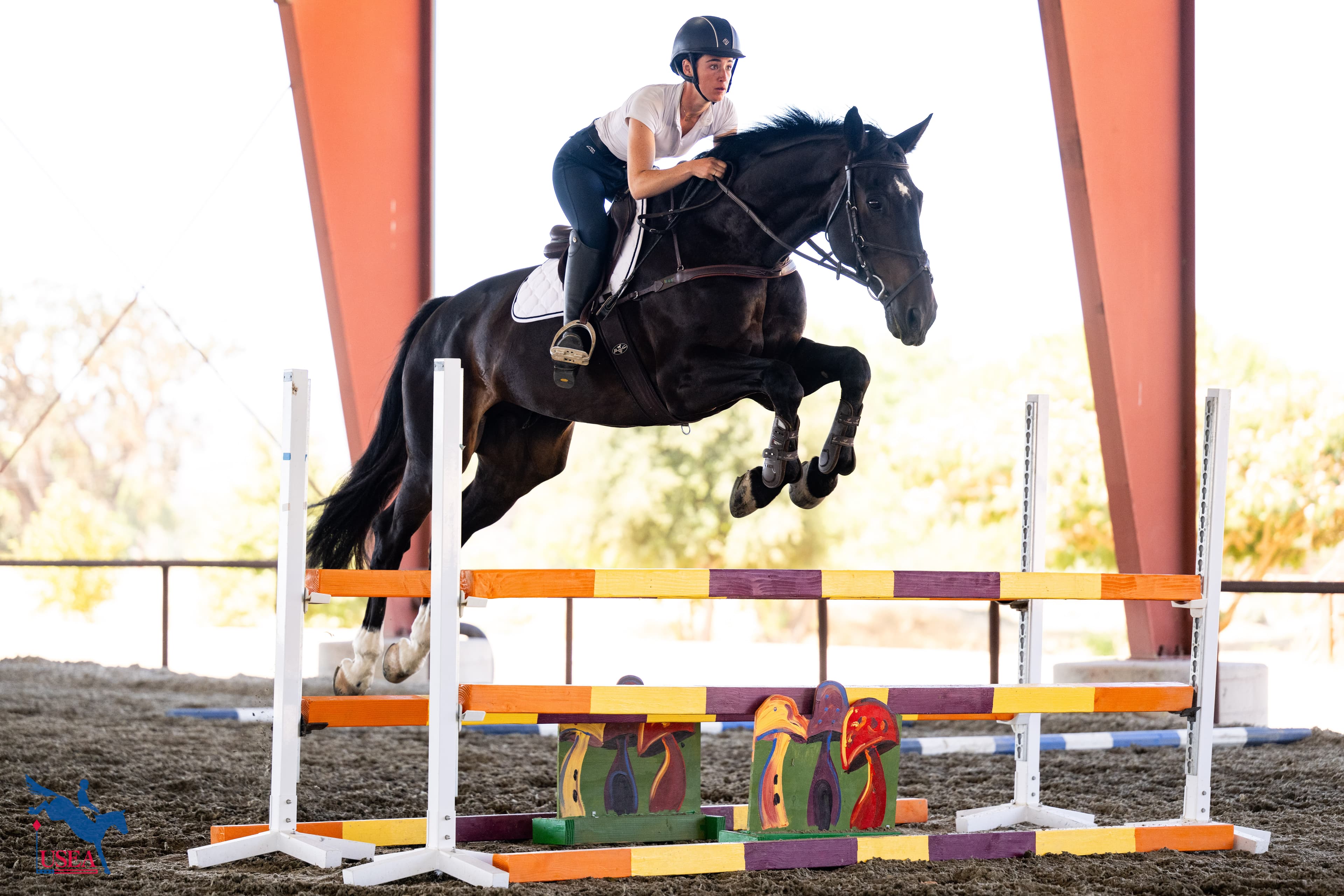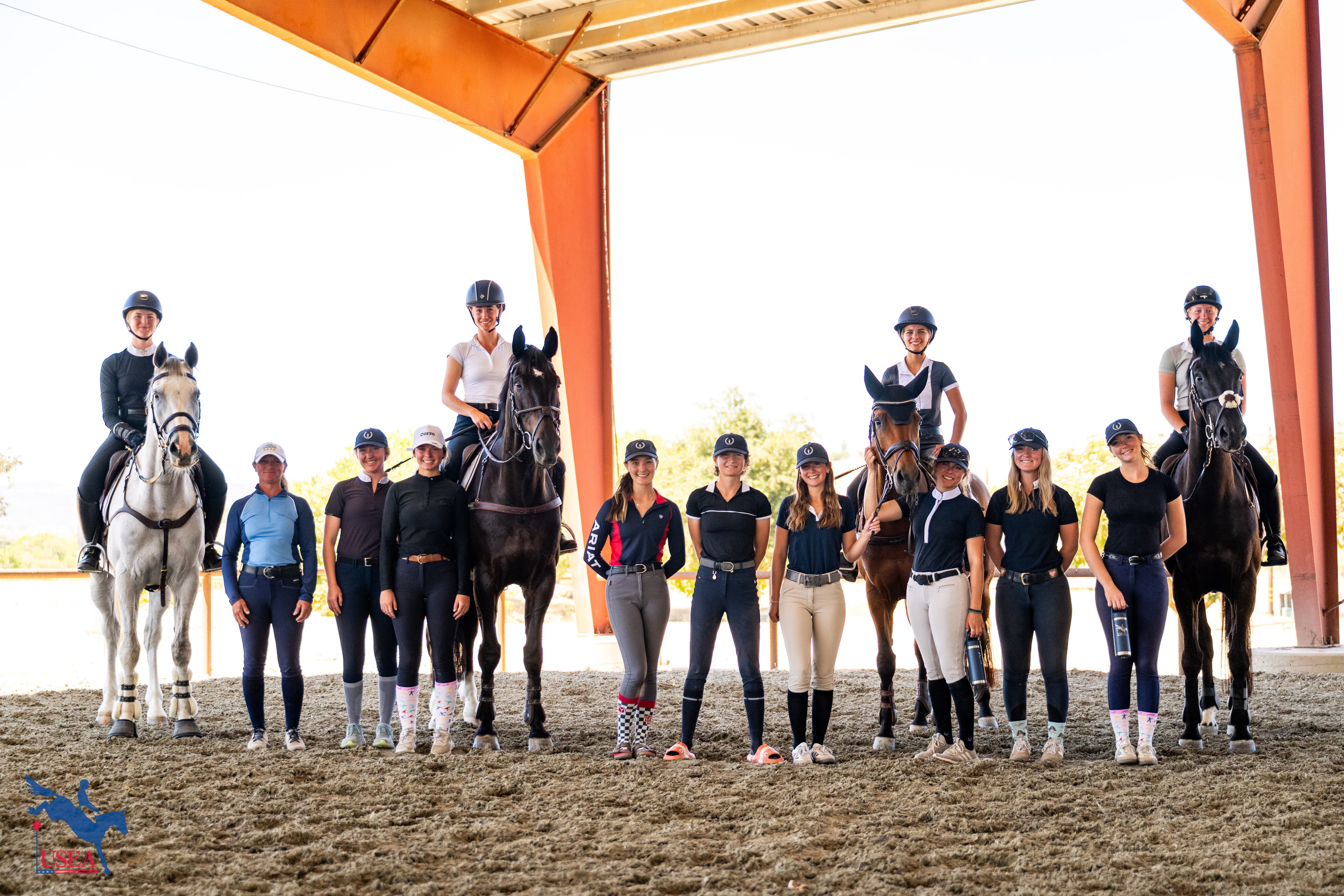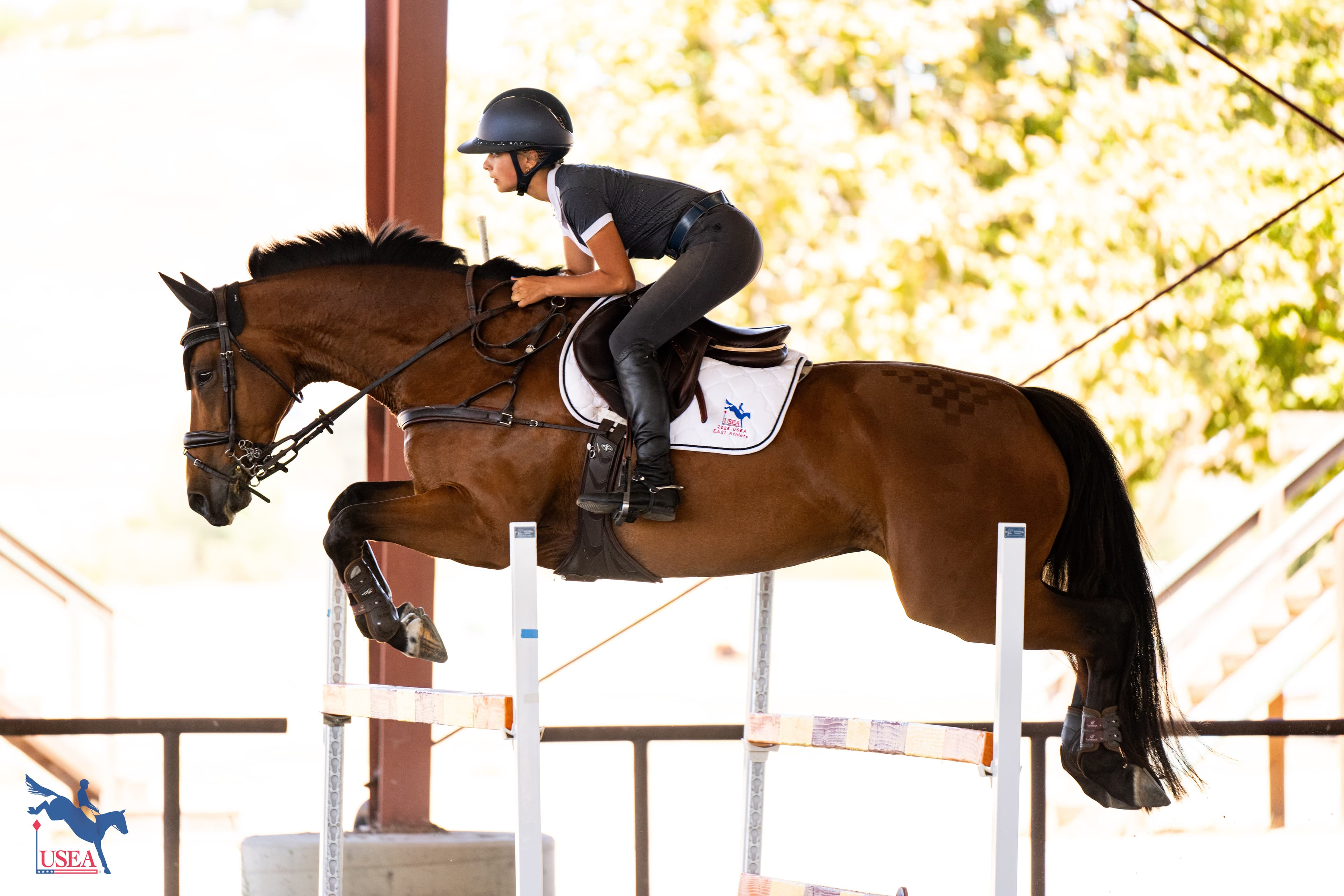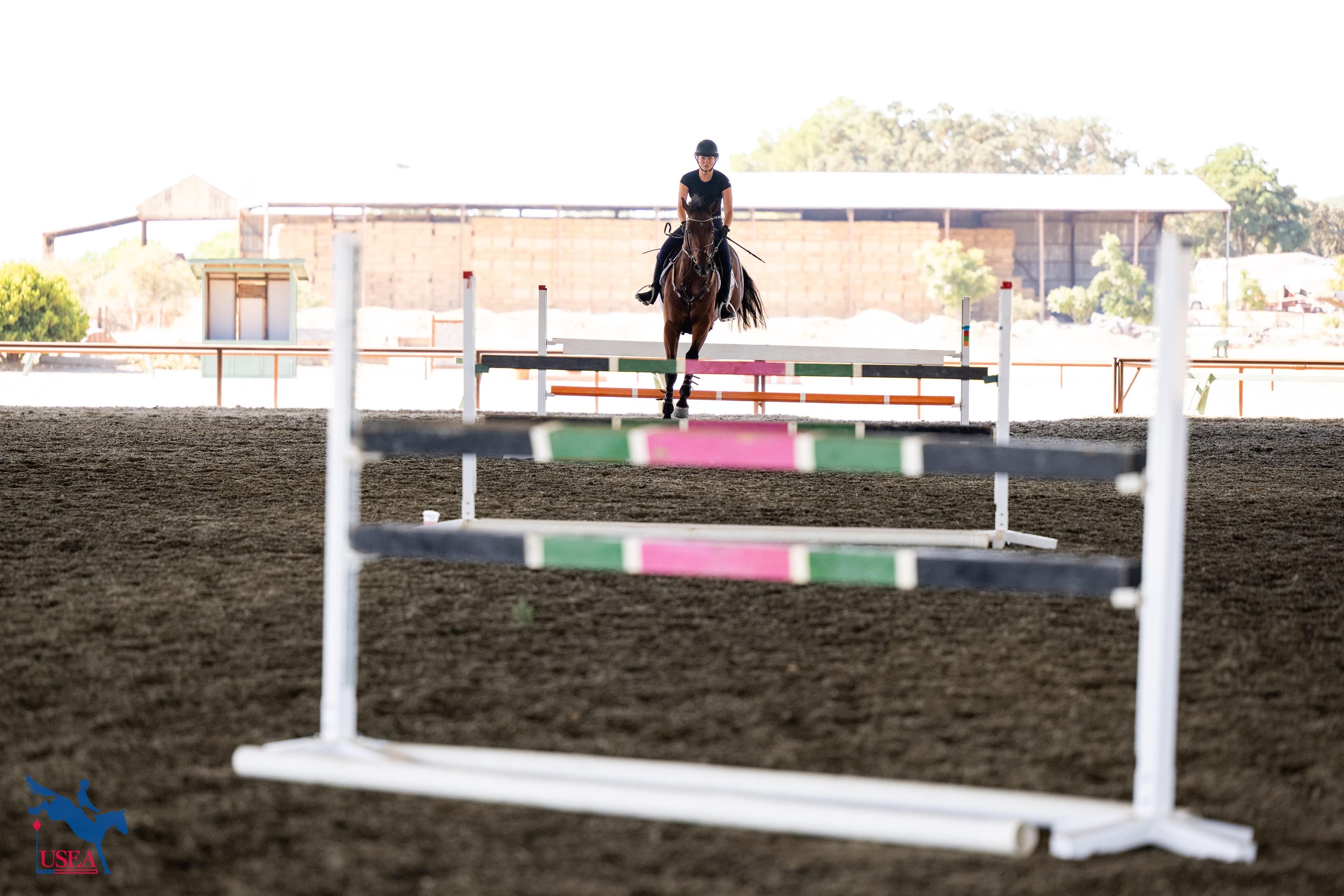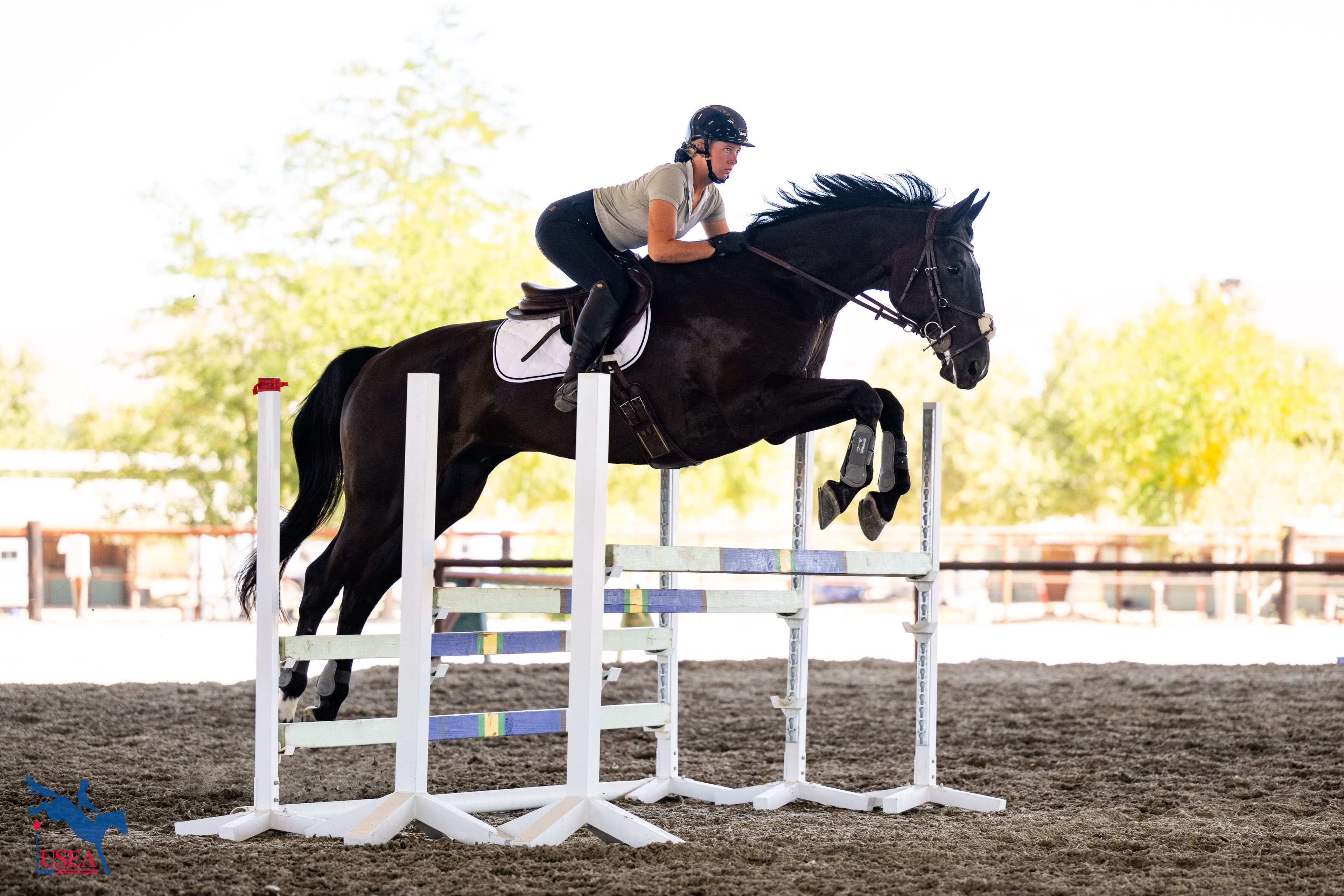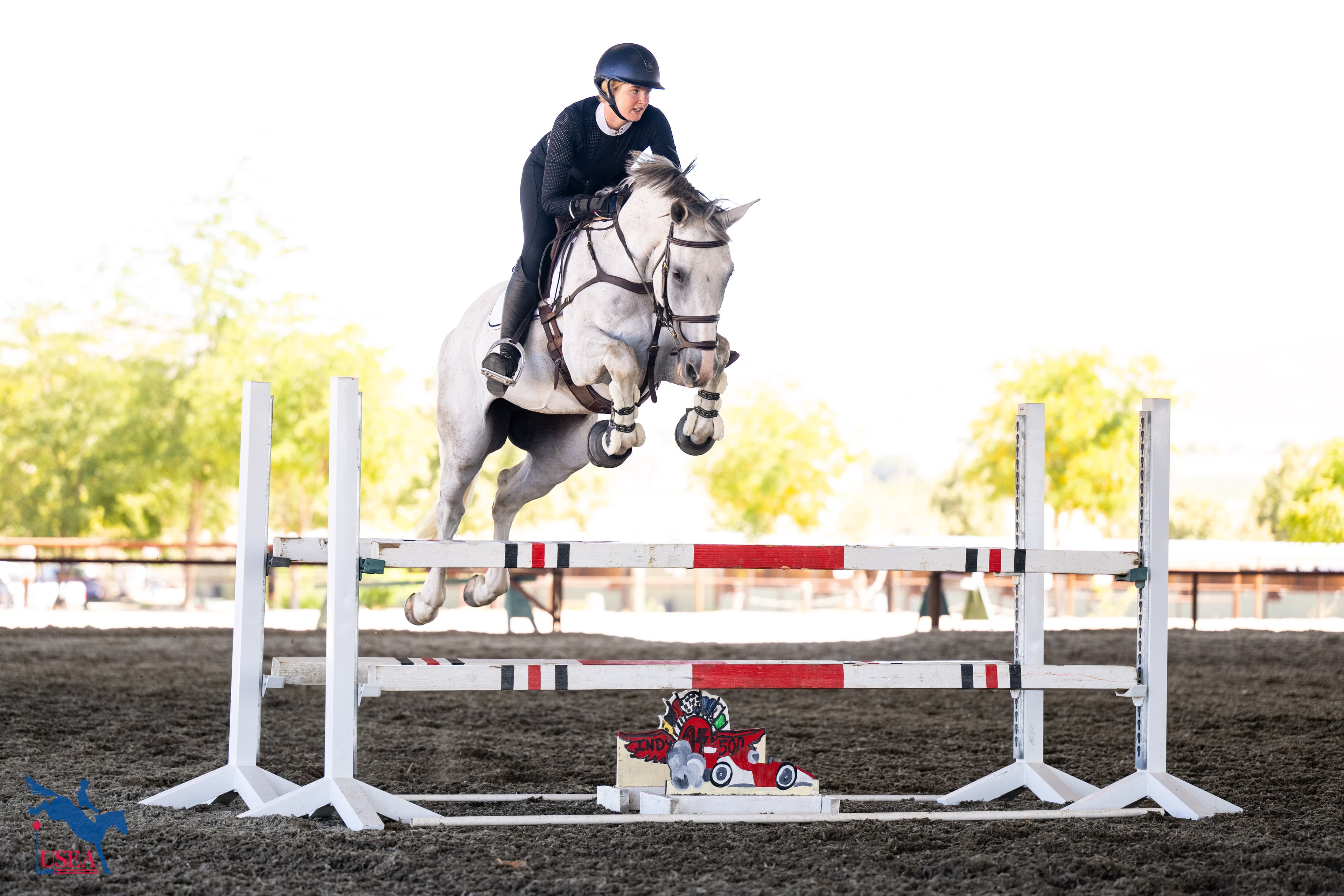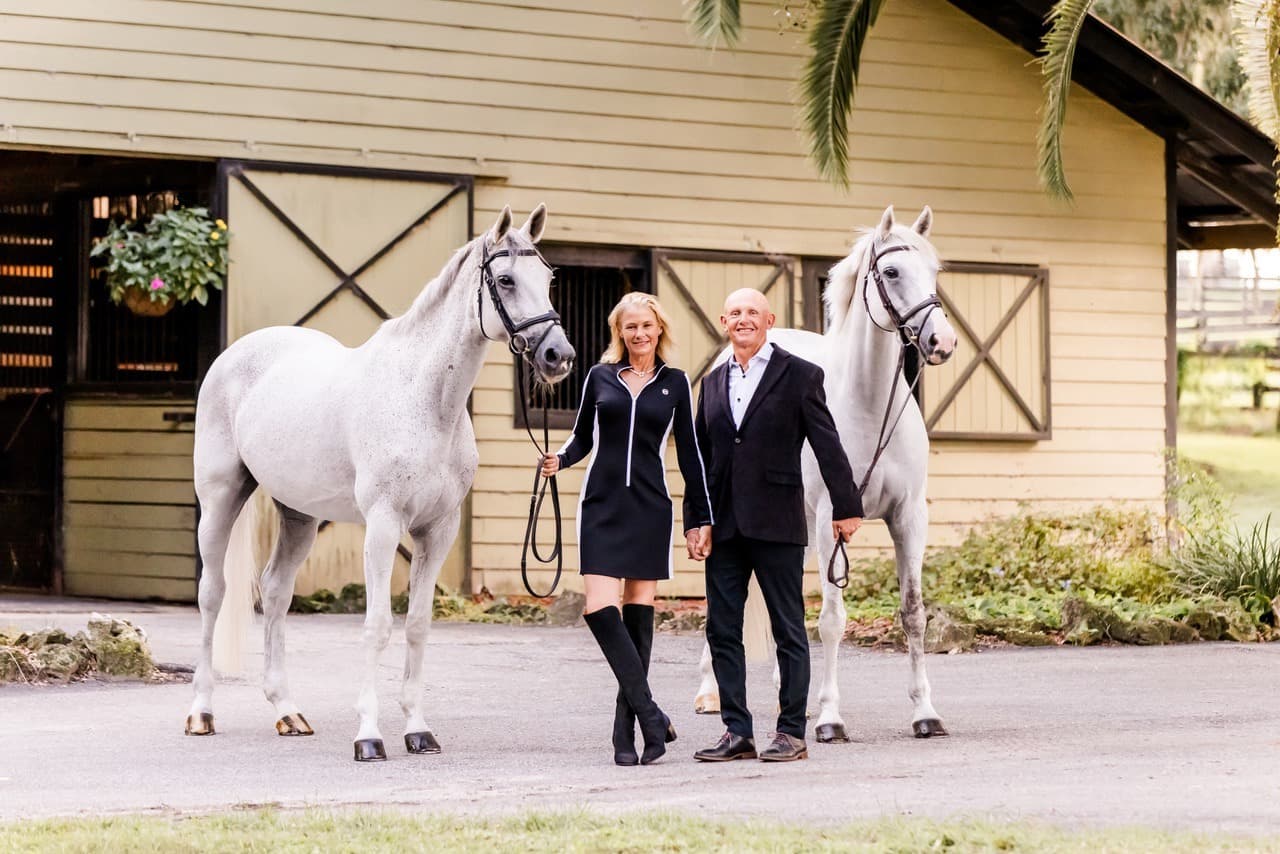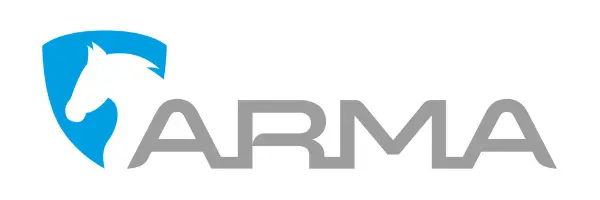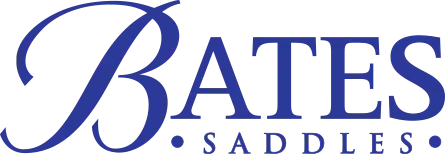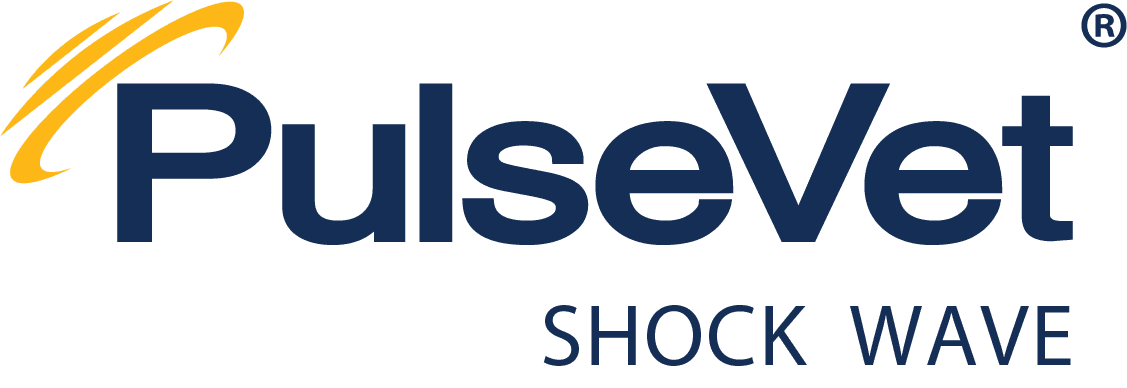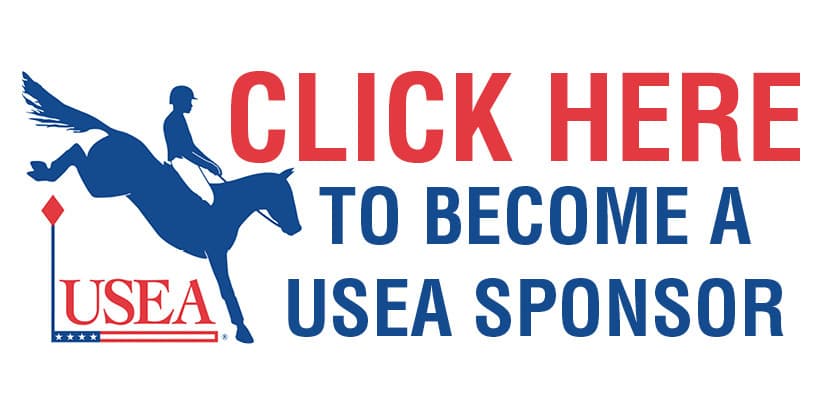Begin As You Mean To Go On Day 2 of the EA21 West I Regional Clinic
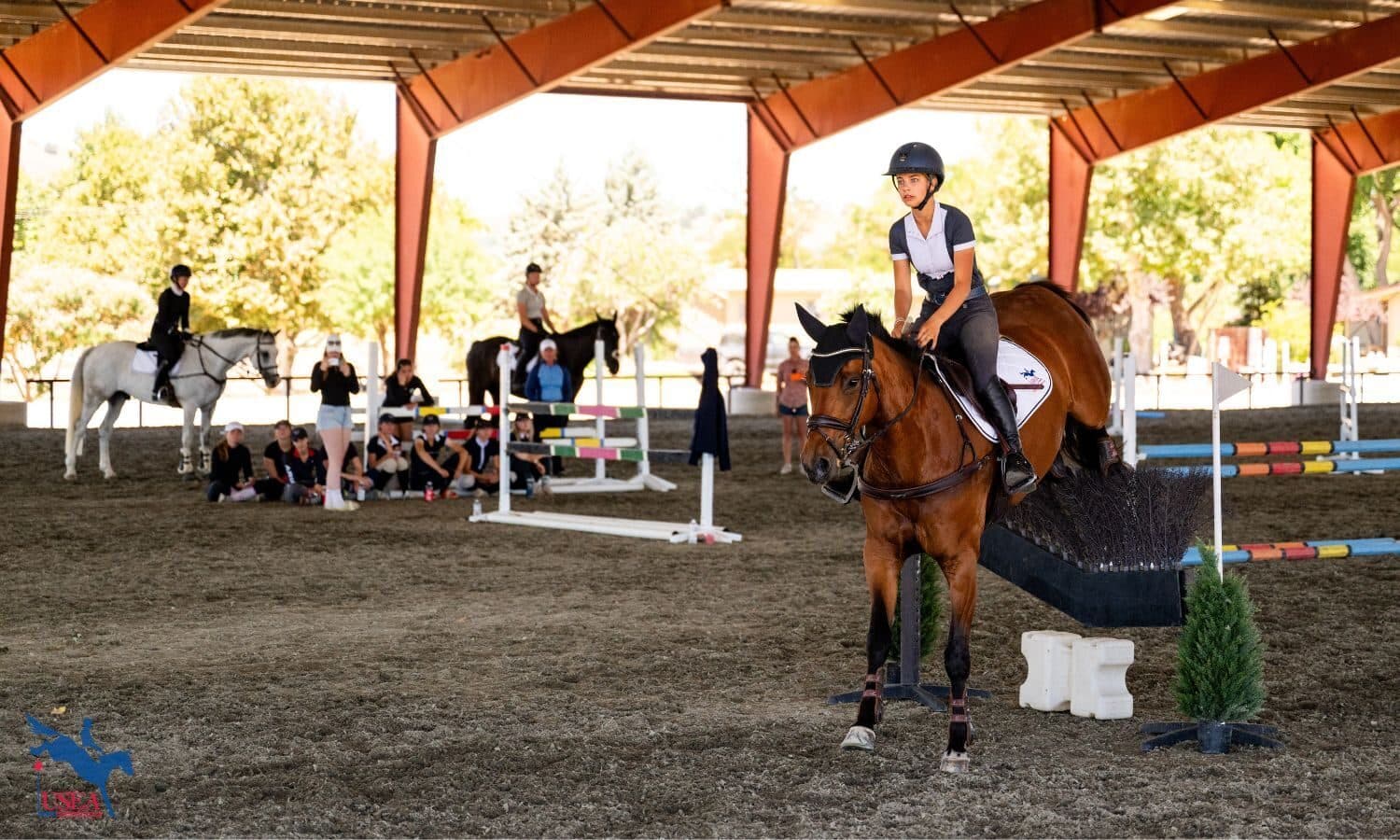
July 30—Paso Robles, Calif.—“In our sport, we need to be able to do so many different things,” said EA21 Coach Emily Mastervich at day 2 of the EA21 West I Regional Cinic at Twin Rivers. “Certain aspects of the jumping have to become instinctive because there’s so much to think about.”
With all the unique challenges of the different phases, specialization doesn’t serve the eventer. But adjusting the ride through a test or a course is a universal technique that lends itself across dressage, show jumping, and cross-country. From collections to extensions, from open striding to turning combinations, having an adjustable ride means not only completing the course successfully but also riding the horse underneath you and not the one you think you have.
Mastervich began each lesson straight away on those adjustments with pole exercises.
Three trot poles set 9’ apart to three cavalettis set 33’ apart to another three poles set 9’ apart encouraged a holding then opening pattern depending on the gait. At the trot, the poles were set with two trot steps between each or a bounce at the canter. The cavalettis were set on an open two canter strides that could easily become three before going back to a slightly more holding distance with the poles again.
Each group of four were encouraged to see how their horses responded to the question first at a posting trot, then sitting, then standing in two-point, before attempting at the canter. Discovering the horse’s footwork for the day and how forward they were thinking helped to set the tone for the type of adjustments needed for the courses to come.
As the German Training Scale describes, riders needed to maintain their rhythm first before working up the pyramid through suppleness, contact, impulsion, straightness, and collection in just the pole work.
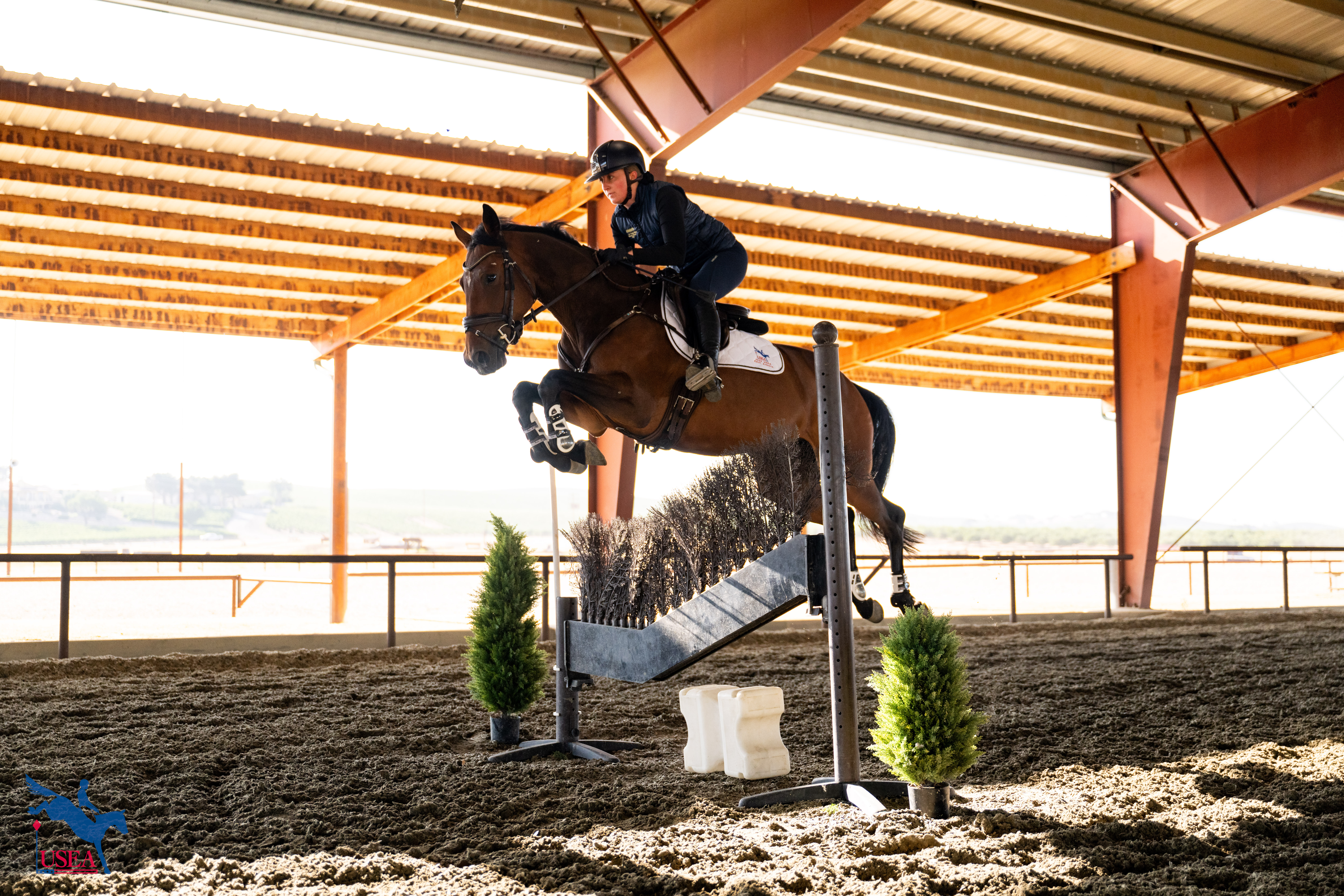
From the poles, riders were then asked to complete a combination set on four and a half strides, adjusting their ride as they came in to hold for the five or go for the four.
Turning lines to mimic cross-country questions were next with an oxer bending to an oxer with a vertical added after the first round to increase the difficulty. Finally, angled combinations were introduced in both angled vertical lines and shoulder brushes.
By breaking the pieces of the course into smaller portions and introducing the horses to each element one at a time, each rider was able to easily navigate the challenging turns and angles while being able to work on their adjustability, whether they were on a green ride or a FEI veteran.
“It's important to keep going back to the base, and a lot of the times when things fall apart at the upper levels, it's because people get too stuck on the higher end of the training scale, and they have to keep coming back to the foundation,” Mastervich commented. Throughout the two days, there was a lot of information imparted to the riders in riding lessons and lectures. “The enthusiasm, everyone was really quick to make any adjustments we talked about. They were all really involved in watching the lessons and in the talks. They're just really engaged.”
That engagement shows in the rapid absorption in their riding corrections based on Mastervich’s feedback but also in their takeaways from the program this week.
“Programs like this are such vital part of developing young riders that one day want to do this for their livelihoods, their professions, and the passion of the sport,” Gabriella Ringer, a repeat participant in the EA21 program, said. “I think it's such a good opportunity to really immerse ourselves and get guidance from people at the top of the sport. We get two days of very focused lessons, both dressage and show jumping, and that's just invaluable.”
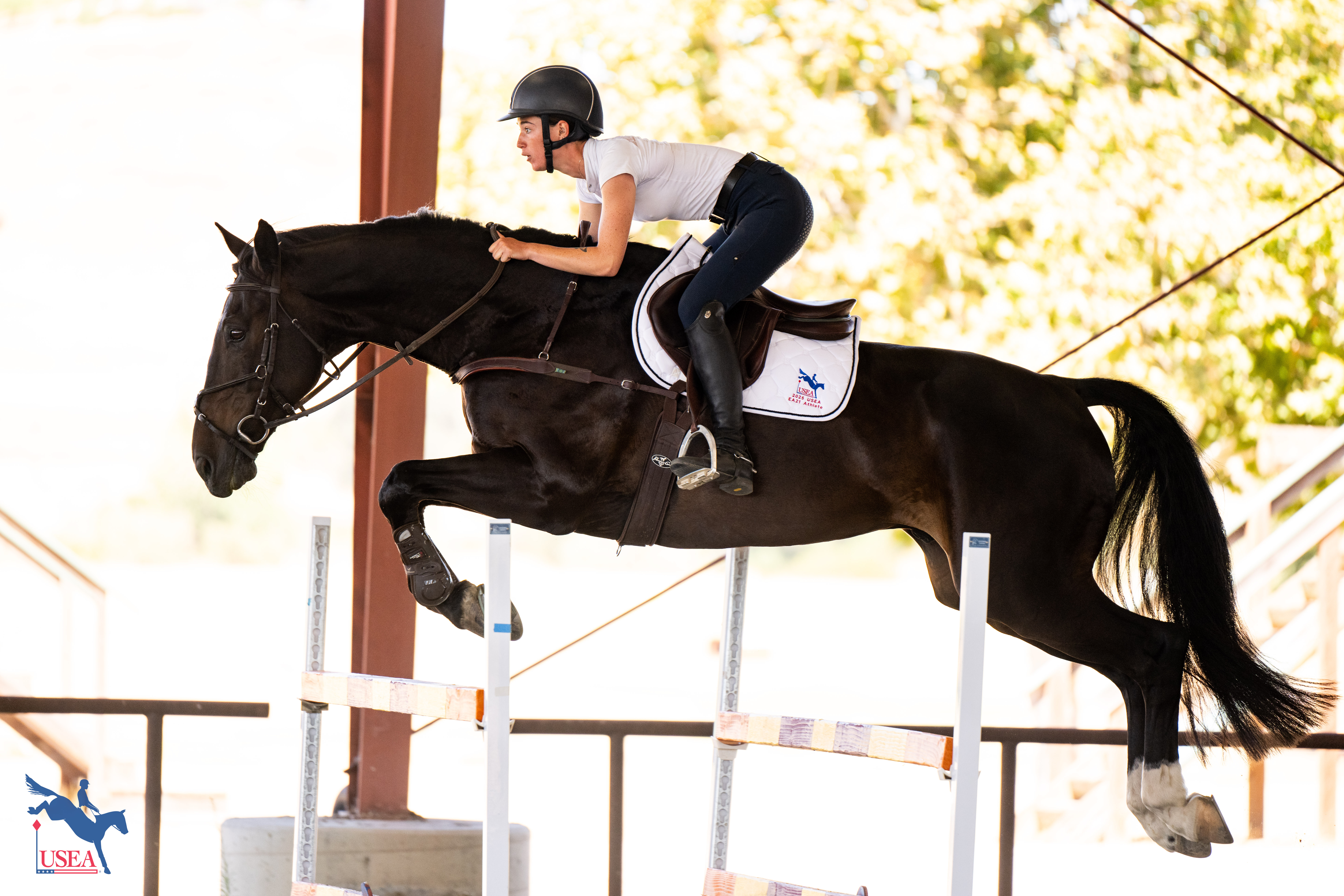
She added that the jumping “was really helpful to see through someone else's eyes. [Mastervich] said something very interesting today, and she asked me to bridge my reins, because my horse turns, but not necessarily through his whole body. Her asking me to bridge the reins and really connect the outside rein and the inside rein and move him over as a unit to do a difficult, tight turn, was very helpful. It showed me that I could maneuver him, a big horse, in a way that I didn't know I could before.”
AnniePearl Stroud has recently made the move from Texas to California and found the EA21 program a gift to both furthering her education and meeting more of her new community. “Knowing that I was going to be out on the West Coast, I wanted to take full advantage of all the opportunities out here. My biggest takeaway is constantly checking in and riding what's under you, not what you want to be under you, especially on the flat and then today in the jumping. I [need to] always be there for support and guiding through the turns.”
“I really love learning,” Anya Ostrovsky said of her first time participating. “I just love going to any clinics and learning from the top professionals and how different people ride their horses differently. It's been super cool to have Emily here, not only as a top rider, but also as a teacher for us to teach us how to take feedback from coaches. I think it's been really helpful with the curriculum that we are provided with to learn how to be a good professional and tailoring it to your own program and your own horses, seeing what works for you. It's just been great to get a sense of how to ride every horse as an individual, instead of trying to apply the same things to every horse.”
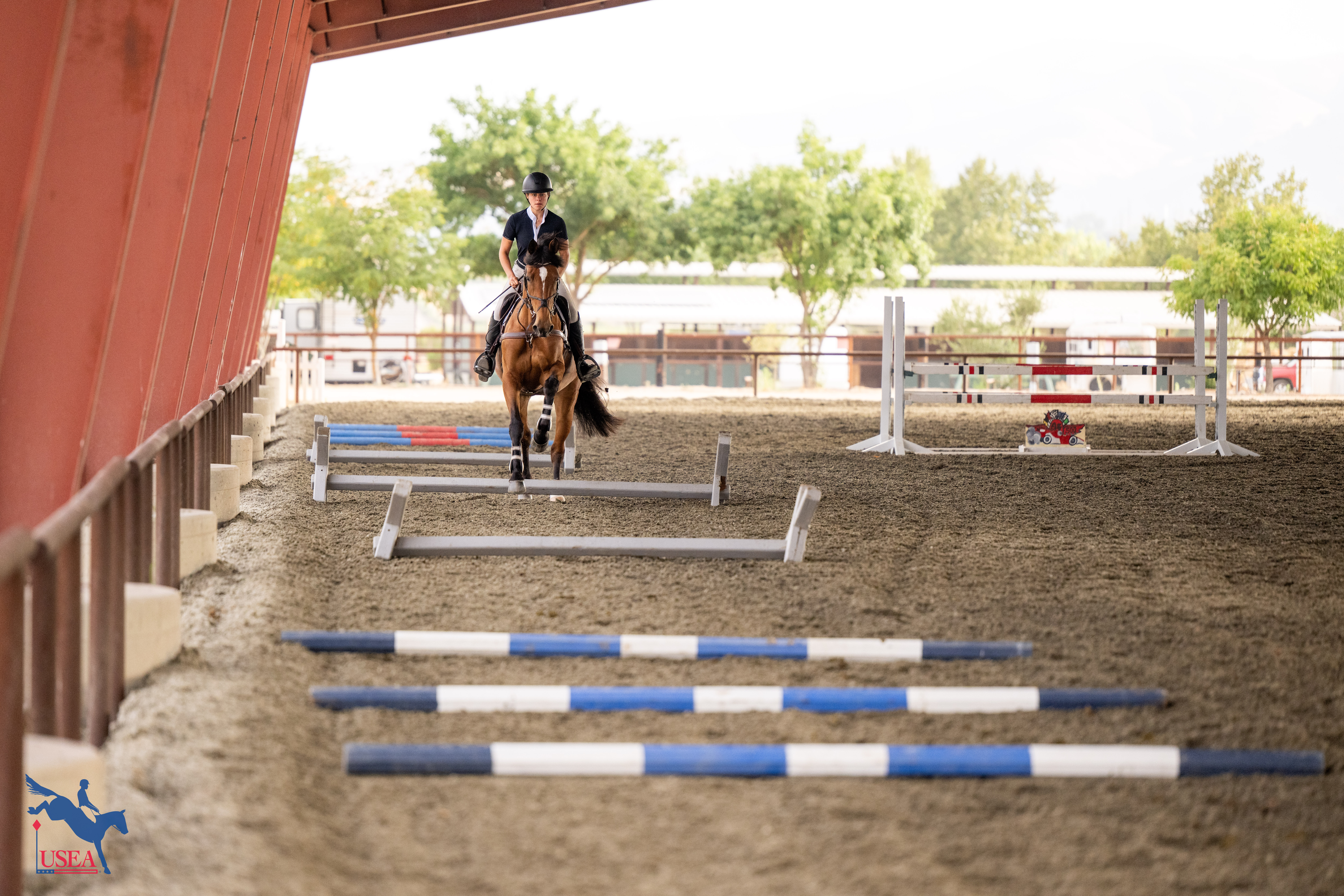
For Julia Beauchamp Crandon, a fourth time participant, the learning never stops. “Before I started in this program, I hadn't ridden a lot of different horses, but now that I've gone through the program and gotten more experience, I've ridden more horses, and applying what's been told to me through the program, it makes more sense every year. I can pick out things in a different way than I did the year before, because it makes sense to me now. Something that I was really struggling with last year now would be just like something I don't even think about this year. The program as a whole is really good at getting people to understand horsemanship, how horses think and how they work, and how rider body mechanics affect your horse and everything you do.”
The USEA’s EA21 clinics will continue on Aug. 12-13 with the West Coast II Clinic at Aspen Farms in Yelm, Washington. Click here for more information.
The USEA would like to thank Twin Rivers for hosting and on-site coordinator Teresa Harcourt for her work this week, as well as coach Emily Mastervich for her excellent teaching!
West I | Twin Rivers | Paso Robles, California
The Participants:
- Olivia Baca
- Camille Batoy (First alternate accepted from Waitlist)
- Julia Beauchamp Crandon
- Paige Beauchamp Crandon
- Greylin Booth
- Amanda Boyce
- Jillian Mader
- Gabriella Ringer
- Kylie Scott
- Emma Slocum
- AnniePearl Stroud
- Anya Ostrovsky
Don't forget to follow the USEA’s coverage on social media!
Facebook | Instagram | Threads
About the USEA Emerging Athlete U21 Program (EA21)
The purpose of the USEA Emerging Athletes U21 Program (EA21) is to identify and provide consistent quality instruction to the next generation of elite event riders. The aim is to create a pipeline for potential team riders by identifying and developing young talent, improving horsemanship and riding skills, and training and improving skills and consistency.
The USEA Emerging Athletes U21 Program was launched in 2022 with a model of five summertime regional clinics taught by carefully selected USEA Eventing Coaches Program (ECP) coaches, leading to a winter national camp consisting of selected Young Riders from the regional clinics. Athletes who are 21 years or younger, are current members of their USEA Young Rider Area program, and are established at the Training Level or higher, are eligible to apply for the EA21 program. Click here to learn more about the USEA EA21 Program.
The USEA would like to thank ARMA, Bates Saddles, Horse Illustrated, Kerrits, PulseVet, Ride iQ, Schneiders Saddlery, Sidelines Magazine, WeRideTogether, and YETI for sponsoring the USEA Emerging Athletes U21 Program.
